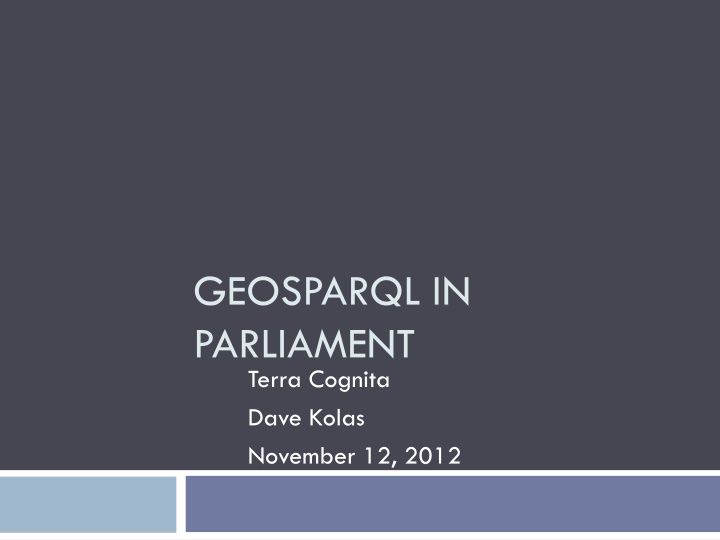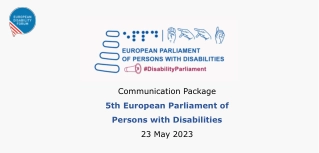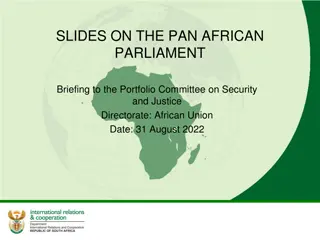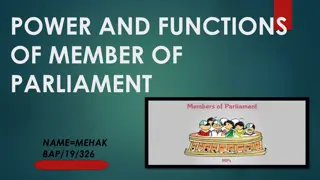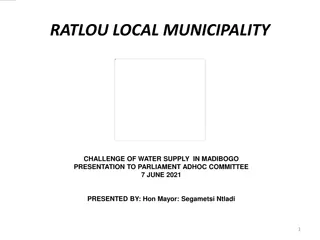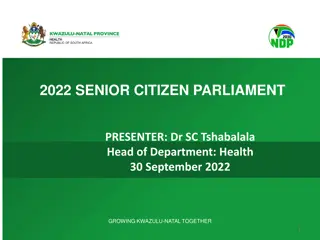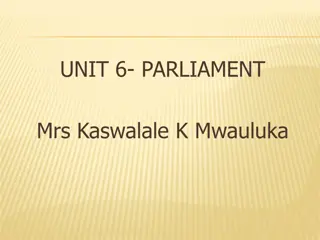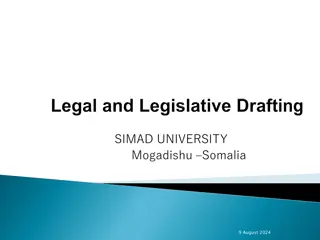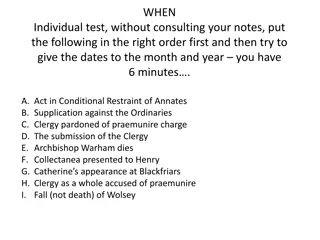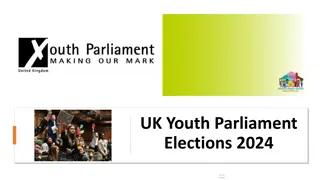Overview of GeoSPARQL Implementation in Parliament
Explore the GeoSPARQL implementation in Parliament, a triple store with SPARQL support used for over a decade. Learn about its design, indexing strategy, spatial features, and missing components compared to GeoSPARQL standards. Discover how Parliament supports GML and WKT literals, various spatial relations, and the challenges it faces in fully implementing GeoSPARQL specifications.
Uploaded on Sep 21, 2024 | 1 Views
Download Presentation

Please find below an Image/Link to download the presentation.
The content on the website is provided AS IS for your information and personal use only. It may not be sold, licensed, or shared on other websites without obtaining consent from the author.If you encounter any issues during the download, it is possible that the publisher has removed the file from their server.
You are allowed to download the files provided on this website for personal or commercial use, subject to the condition that they are used lawfully. All files are the property of their respective owners.
The content on the website is provided AS IS for your information and personal use only. It may not be sold, licensed, or shared on other websites without obtaining consent from the author.
E N D
Presentation Transcript
GEOSPARQL IN PARLIAMENT Terra Cognita Dave Kolas November 12, 2012
Parliament Parliament In continuous customer use for ~10 years (Originally DAML-DB) Triple Store with SPARQL support Implemented as a persistence layer for Jena/Sesame Includes spatial and temporal indexing/processing Open source! http://parliament.semwebcentral.org/
Design 3 Part of Jena Spatial Index Processor Joseki Parliament Framework External Storage Model Spatial Index (deegree) IndexingGraph Temporal Index Processor Temporal Index (BDB) Parliament Graph Parliament (C++)
Parliaments Indexing Strategy Applications often require efficient statement insertion Goal: Balanced insertion, query performance, and space required Parliament stores triples using two components: Resource dictionary Statement table Additional indices can be added for specific purposes and vocabularies Spatial Index Temporal Index
Parliaments Spatial Index First created before GeoSPARQL, used terms derived from GeoRSS Now supports most of GeoSPARQL specification Index is based on R tree in deegree library (deegree.org) Approach: Explicit geometries, no qualitative reasoning Optimization so far on triple patterns, not functions
GeoSPARQL Implementation Parliament supports: Both GML and WKT literals, and can interchange between them All three vocabularies for spatial relations (simple features, rcc8, and Egenhofer) Triple-pattern spatial relations Filter functions for spatial relations and spatial combinations A large number of coordinate reference systems RDFS Reasoning
GeoSPARQL Missing Pieces The following features of GeoSPARQL are not currently implemented in Parliement: Feature-to-feature spatial relations via query rewriting Optimization on FILTER functions Qualitative reasoning Standard properties for Geometry dimension, spatialDimension, isEmpty, isSimple, hasSerialization Function getSRID
Parliaments Temporal Index Parallel to spatial index Terminology taken from OWL-Time (using Allen relations for overlapping intervals, etc) Uses Java version of Berkeley DB for persisting index
Build Process Improvements Until very recently, GeoSPARQL support was on a branch, and required building for your desired platform GeoSPARQL support has been merged into the trunk and prebuilt binaries are now available for Windows, Mac, and Linux Parliament build structure has been improved again to require fewer dependencies
Examples Data on geosparql.bbn.com Data sets: USGS data in Atlanta, GA Rails, Rivers Geonames data Administrative areas Points for buildings, such as schools
Example Query 1 Find All Schools within Georgia SELECT DISTINCT ?school WHERE { GRAPH <http://example.org/data> { # get Georgia geometry gu:_1705317 geo:hasGeometry ?ga_geo . # get schools within Georgia ?school a gn:Feature ; geo:hasGeometry ?school_geo ; gn:featureCode gn:S.SCH . ?school_geo geo:sfWithin ?ga_geo . } }
Example Query 2 Find Geonames features within 10k of the Nixon Grove School SELECT ?x WHERE { GRAPH <http://www.geonames.org> { <http://sws.geonames.org/4212826/> geo:hasGeometry ?geo1 . ?geo1 geo:asWKT ?wkt1 . BIND (geof:buffer(?wkt1, 10000, units:metre) as ?buff) . ?x geo:hasGeometry ?geo2 . ?geo2 geo:asWKT ?wkt2 . FILTER (geof:sfContains(?buff, ?wkt2)) } }
